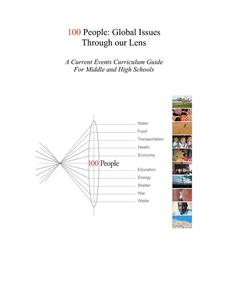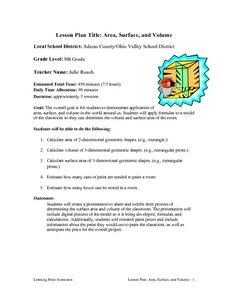Curated OER
Unit 2: Post-Revolution: The Critical Period 1781-1878
The post-Revolutionary Period of 1781-1787, also known as the Critical Period, is the focus of a series of lessons that prompt class members to examine primary source documents that reveal the instability of the period of the...
NASA
Earth's Global Energy Budget
Introduce your earth science enthusiasts to the earth's energy budget. Teach them using an informative set of slides that include illuminating lecturer's notes, relevant vocabulary, embedded animations, colorful satellite maps, and a...
McAuliffe-Shepard Discovery Center
Global Warming in a Jar
This well-organized lab activity introduces earth science pupils to the greenhouse effect. They will set up two experiments to monitor temperatures in an open jar, a closed jar, and a closed jar containing water. Ideally, you would have...
100 People Foundation
100 People: Global Issues Through Our Lens
If the world were 100 people...17 would not have access to safe drinking water, 18 would not be able to read or write, and 52 would not have a primary education. Using the theme of "100 people," this resource explores other major issues...
Curated OER
Out of the Dust: Narrative Essay
To conclude their study of Out of the Dust, the 1998 Newbery Medal winning verse novel, individuals craft a narrative essay based on one of the themes in Karen Hesse's novel.
Word Up Project
Mini Games
You've got a few minutes left at the end of class to practice vocabulary, but what can you do other than call out a word and ask for definitions? Play one of these 12 quick games! Each game is explained in detail and easy to modify for...
Curated OER
SOME BASIC LESSON PRESENTATION ELEMENTS
Students review the Madeline Hunter Direct Instruction Model. They incorporate objectives, standards, anticipatory set and modeling. Students use guided practice/monitoring and closure daily.
Curated OER
Planning a Healthy City
Ninth graders create a scaled model city. They create a blueprint that provides for the economic and cultural needs of a community. They identify where essential elements of the city should be located and explain the rationale for the...
Curated OER
Social Studies
Third graders explore maps and models. They discuss communities and the buildings within their community. Students construct a model of the downtown area of their town. They construct a map of their town and write facts about the...
Curated OER
Multi-Dimensional Thinking
Pupils brainstorm new technological devices that apply cutting-edge 3-D computer modeling software to benefit different professions.
Curated OER
Castles and Fortresses of the World
Students work in groups to study castlers and fortresses of the world. They study pictures and models of well known castles and fortresses. Students construct a 3-D model of a castle or fortress using materials of their choice.
Curated OER
Cells
Young scholars explore the cell and cell processes. They create "cytoplasm", make a model of the cell and its organelles, and simulate the osmosis and the diffusion of materials into and out of the cell.
Curated OER
How can we write a silly story?
Second graders use the writing process and create a silly story. In this silly story instructional activity, 2nd graders will review person, event and setting and complete a chart for each. Students will put a person,...
Curated OER
IKnow IMac
Students familiarize themselves with specifications used to describe models of computers by researching and developing a consumer guide.
Curated OER
Cells, Cells, Cells
Students explore plant and animal cells. Using household items, students create a three-dimensional model of a plant or animal cell. Students identify and label each cell part.
Curated OER
Neurology Lessons
Students create a model of a neuron using household items. They bring these items to school for model construction. Students utilize the Internet and other sources to categorize assigned chemical/neurotransmitter. They also utilize...
Curated OER
Food Webs and Making Miniature Ecosystems
Students model a food web and create a miniature ecosystem. In this animal interactions lesson, students engage in a role playing game which simulates a food web. Students then build miniature ecosystems using pop bottles, snails, plants...
Curated OER
Keep on Standing!!
Students conduct research on the Internet about earthquakes and buildings that have withstood them. They suggest designs for future buildings. They create models of their suggested designs. Their models are tested in an earthquake...
Curated OER
Area, Surface, and Volume
Ninth graders demonstrate application of area, surface, and volume. They apply formulas to a model of the classroom so they can determine the volume and surface area of the classroom.
Curated OER
Problem Solving Process: One-To-One Correspondence
First graders observe and demonstrate a variety of problem solving strategies to solve problems involving one-to-one correspondence and whole numbers to 100. They discuss the steps of the problem solving process, and solve a word...
Curated OER
Tomas and the Library Lady
Students practice read aloud comprehension strategies. In this literacy comprehension lesson, students listen to Tomas and the Library Lady, stopping to discuss with a partner aspects of the story suggested by the teacher. Students make...
Curated OER
Adding and Subtracting Polynomials Using Algebra Tiles
Learners add and subtract polynomials. In this algebra lesson, students use algebra tiles to perform operation of polynomials. They model their problems and understand how to combine like terms using tiles.
Institute of Electrical and Electronics Engineers
Clipper Creations
Students create their own model of a nail clipper. They practice using engineering design and model building. They also identify different kinds of small levers.
Curated OER
African Power Figure Sculptures
Students develop character, write short narrative about how it got its powers, and create a clay figure using modeling and assembling techniques to explore the concepts relating their figure to the African power figures.























